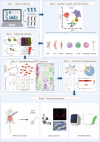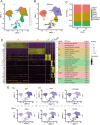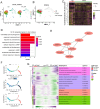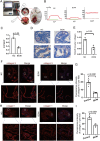Single-cell RNA sequencing reveals critical modulators of extracellular matrix of penile cavernous cells in erectile dysfunction
- PMID: 38467692
- PMCID: PMC10928087
- DOI: 10.1038/s41598-024-56428-0
Single-cell RNA sequencing reveals critical modulators of extracellular matrix of penile cavernous cells in erectile dysfunction
Abstract
Erectile dysfunction (ED) is a common and difficult to treat disease, and has a high incidence rate worldwide. As a marker of vascular disease, ED usually occurs in cardiovascular disease, 2-5 years prior to cardiovascular disease events. The extracellular matrix (ECM) network plays a crucial role in maintaining cardiac homeostasis, not only by providing structural support, but also by promoting force transmission, and by transducing key signals to intracardiac cells. However, the relationship between ECM and ED remains unclear. To help fill this gap, we profiled single-cell RNA-seq (scRNA-seq) to obtain transcriptome maps of 82,554 cavernous single cells from ED and non-ED samples. Cellular composition of cavernous tissues was explored by uniform manifold approximation and projection. Pseudo-time cell trajectory combined with gene enrichment analysis were performed to unveil the molecular pathways of cell fate determination. The relationship between cavernous cells and the ECM, and the changes in related genes were elucidated. The CellChat identified ligand-receptor pairs (e.g., PTN-SDC2, PTN-NCL, and MDK-SDC2) among the major cell types in the cavernous tissue microenvironment. Differential analysis revealed that the cell type-specific transcriptomic changes in ED are related to ECM and extracellular structure organization, external encapsulating structure organization, and regulation of vasculature development. Trajectory analysis predicted the underlying target genes to modulate ECM (e.g., COL3A1, MDK, MMP2, and POSTN). Together, this study highlights potential cell-cell interactions and the main regulatory factors of ECM, and reveals that genes may represent potential marker features of ED progression.
Keywords: Erectile dysfunction; Extracellular matrix; Microenvironment; Modulator; Single-cell sequencing.
© 2024. The Author(s).
Conflict of interest statement
The authors declare no competing interests.
Figures









Similar articles
-
Single-cell transcriptome analysis of cavernous tissues reveals the key roles of pericytes in diabetic erectile dysfunction.Elife. 2024 Jun 10;12:RP88942. doi: 10.7554/eLife.88942. Elife. 2024. PMID: 38856719 Free PMC article.
-
Pathway analysis of microarray data from corpora cavernosal tissue of patients with a prostatectomy or Peyronie disease in comparison with a cavernous nerve-injured rat model of erectile dysfunction.J Sex Med. 2023 Feb 14;20(2):139-151. doi: 10.1093/jsxmed/qdac019. J Sex Med. 2023. PMID: 36763930 Free PMC article.
-
Pathway Enrichment Analysis of Microarray Data Fom Human Penis of Diabetic and Peyronie's Patients, in Comparison With Diabetic Rat Erectile Dysfunction Models.J Sex Med. 2022 Jan;19(1):37-53. doi: 10.1016/j.jsxm.2021.10.004. Epub 2021 Nov 25. J Sex Med. 2022. PMID: 34838480 Free PMC article.
-
Targeting vascular structure for the treatment of sexual dysfunction.J Sex Med. 2009 Mar;6 Suppl 3:210-20. doi: 10.1111/j.1743-6109.2008.01174.x. Epub 2009 Feb 4. J Sex Med. 2009. PMID: 19207270 Review.
-
Erectile dysfunction: anatomical parameters, etiology, diagnosis, and therapy.Arch Androl. 2005 Jan-Feb;51(1):15-31. doi: 10.1080/1485010490475147. Arch Androl. 2005. PMID: 15764414 Review.
Cited by
-
Identification of dynamic network biomarker ITGB1 for erlotinib pre-resistance using single-cell differential covariance entropy.Mol Ther Oncol. 2025 May 15;33(2):200993. doi: 10.1016/j.omton.2025.200993. eCollection 2025 Jun 18. Mol Ther Oncol. 2025. PMID: 40546313 Free PMC article.
-
Identification of fibrosis-related genes and biomarkers in diabetic erectile dysfunction.Sex Med. 2025 Jan 9;12(6):qfae090. doi: 10.1093/sexmed/qfae090. eCollection 2024 Dec. Sex Med. 2025. PMID: 39790563 Free PMC article.
References
MeSH terms
Grants and funding
LinkOut - more resources
Full Text Sources
Medical
Research Materials
Miscellaneous

